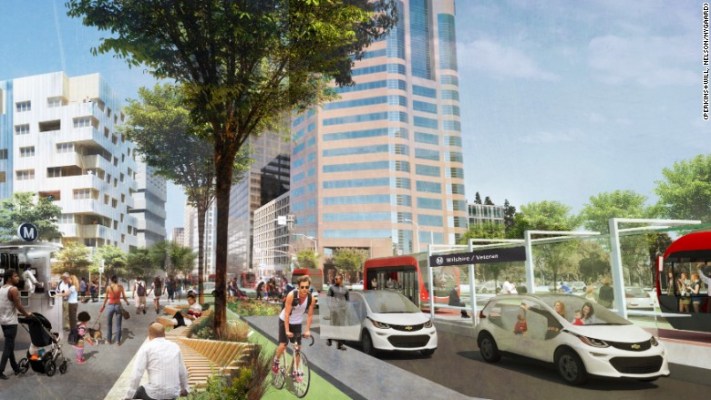Lyft’s focus on future autonomy isn’t just about partnering with self-driving car companies like Drive.ai, or with providing an open network upon which an autonomous ride hailing service can be built – it’s also working with design firms and other stakeholders to try to foresee future streets intentionally built to facilitate autonomous transportation.
This is another example of Lyft’s big-picture thinking around autonomy and the future of mobility services – its co-founders, and particularly President John Zimmer, have expressed expansive, blue sky visions of autonomous future in the past. Now, it shared with CNN a potential blueprint for what a redesigned major roadway in traffic-choked Los Angeles might become with some relatively near-to-hand autonomous tech actually running on roads.
Lyft’s vision, created with architectural firm Perkins+Will and transportation consultant agency Nelson/Nygaard, actually reduces the 10-lane current design of LA’s Wilshire Boulevard down to just three narrowed lanes for cars, along with dedicated lanes for autonomous buses. The idea is to incentive shared, self-driving modes over individual, manually driven vehicles – while also opening up green space and pedestrian- and bike-friendly lanes, too.
The road design has a wider sidewalk, along with park-like fixtures including benches. These would work in tandem with the dedicated bus lanes and autonomous multi-passenger vehicles, to provide space that’s enjoyable while you wait.
It’s not generally terribly surprising in terms of how it looks compared to idealized visions of future cities, but it does point out very directly how we might be able to reclaim a significant portion of current urban square footage for resident use – even in the near future, with limited implementation of autonomous vehicle tech. Bus routes, especially dedicated ones, are relatively uncomplicated compared to open self-driving in existing city streets, shared with human-driven vehicles. We could seem them implemented long before consumer have ready access to autonomous technologies at the level of the individual car.
